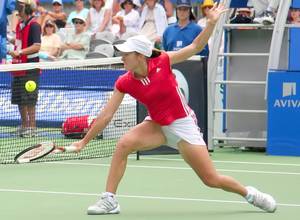Technology in Tennis
Interview with
Britain has recently been celebrating its first Wimbledon Men's Single Champion in 77 years, but between those two victories, the game of tennis has been completely revolutionised. Not just due to the introduction of professional contracts and sponsorship, but also because of technological advances in rackets and balls which allow players to hit record-breaking serves of up to 163 miles an hour. Ginny Smith caught up with Alison Cook from the Sports Engineering Consultants, Cook Associates on a local tennis court to find out about the technology that's changed the game.
in 77 years, but between those two victories, the game of tennis has been completely revolutionised. Not just due to the introduction of professional contracts and sponsorship, but also because of technological advances in rackets and balls which allow players to hit record-breaking serves of up to 163 miles an hour. Ginny Smith caught up with Alison Cook from the Sports Engineering Consultants, Cook Associates on a local tennis court to find out about the technology that's changed the game.
Alison - So, the first development you saw from the Dunlop wooden rackets was aluminium rackets which, aluminium is a much lighter material which maintains a similar strength. And so therefore, the players found it lighter to play with and then easier to swing. But then what we then advanced through was composite materials where you have carbon fibre composites. The essential property that those materials allowed you to have was what we call the swing weight.
Ginny - So, what exactly is the swing weight? I guess, if you're trying to swing a very heavy racket, you have to put a lot more energy into just doing the swing and you don't get as much energy to the ball. Is that the idea?
Alison - Perfect! You've got it in one shot. The best way to think of it is it's the way the weight or the mass is distributed along the length of the racket. Just like if you were carrying a frying pan full of lots of bacon and eggs or something which there's too much in there, you would feel that it was heavier, similar with the tennis racket. If you put more weight into the head of the tennis racket, it will feel heavier to the tennis player and so, the way the weight is distributed along the racket makes a big difference to how they play the shot.
Ginny - So, other than weight, what kind of things have changed in tennis rackets, in the materials they're made of to help people get these really powerful fast serves that we're seeing nowadays?
Alison - The other thing that's changed which is important is the head size. Of course, if you have a bigger head size then you actually have got more strings in there. You've got more ability to store the energy and to then return the energy into the ball. Just to give you the numbers, in 1970, the racket head size was about 70 inches squared and now, they're more like 105 inches squared. The Williams sisters are usually known for playing with one of the largest sizes of racket head, 110 inches which is what the men play with often - the biggest rackets. Even if you don't play tennis, you might have heard of the term 'sweet spot'.
Ginny - Is that the area of the racket that you're aiming to hit the ball with?
Alison - That's right. The place on the strings where the ball receives maximum energy transfer, the maximum power to the ball, it's all about energy transfer. So, the ball is coming with a certain amount of energy towards the tennis player, it hits the strings, the energy is stored into the strings and into the ball, and then the strings return the energy into the ball, and then the ball flies off.
Ginny - So, we've got a pair of rackets here that you brought with you and they look pretty much the same, but there's something different about them. What's that?
Alison - Well, one of the things that affects the player's shots and the power of the player's shots is not only the racket material that it's made of, but also the type of string that's used. All sorts of things will affect that - the length of the string that's used, the type of the string, the cross section of the string, and the tension at which the racket is strung. So, we've got these two rackets here and they're the same racket design. They're the same head size, but they have different strings in them and if you listen to them, you will hear a different noise.
(Low pitch string sound)
(High pitch string sound)
Ginny - So, it sounds quite nice. It sounds a bit like a guitar, but the second one sounded a bit higher pitched to me. Why is that?
Alison - The higher the note, the more tightly strung the racket is. Now, if it's strung more tightly then you lose some power but you gain control. The reason you lose power is because the strings are all about absorbing the energy, elastic potential energy it's called. Just like a rubber band, you store energy into the rubber and then it pings back. That's what the strings are doing. They're storing the energy of the ball into the racket and then they're returning it to the ball. So, if you have a tightly strung racket, you get less power into the strings and then less power back into the ball, but you do gain control. So, that first racket was strung with lower tension and so, there will be more power.
Ginny - So, we've talked a bit about the rackets, but what about balls? How have they changed and how does that affect the game?
Alison - One of the things people will automatically notice when they open a new can of tennis balls is that it makes a really lovely hissing noise. That's because the balls are kept at pressure so that the behaviour of the ball is repeatable. When the balls are manufactured as well, they are pressurised and so, that's why you will notice that when you take a new ball out of a can, most of us will not be able to squash the ball.
Ginny - Okay and you've got a tube of new balls here that we can have a look at.
Alison - Yes, I do. (opens the can)
Ginny - So, what's the difference between these and some balls that have been used for a while?
Alison - Well, we were watching my kids playing earlier and they were playing with some training balls which we've been using for quite a while and they've become very soft with time. That's why when you're watching any Wimbledon match, you'll see that they have new balls every so often. So, they change the balls every 9 games and that's because those players are hitting the balls so hard all the time, they knock the stuffing out of the ball literally and the pressure within the ball deteriorates, and it becomes much softer. So, when you first open a tube of balls like we've just done, it's very hard. It's pressurised inside.
Ginny - I'm trying to squash that in my hand and it's squashing very slightly, but I'm having to put quite a lot of effort in to get any sort of give at all. So, we've got a training ball here which has been used for a while and yeah, I can get quite a good dent in that really quite easily, just by squishing it. So, you can definitely feel the difference there. What kind of difference does that actually make to playing with them?
Alison - So, it's all about the energy transfer. With the new balls, you'll get far more energy transferred into the ball from the racket and the player than when they're soggy. Energy is always conserved. So, when you deform the ball like that, you're actually absorbing energy into the ball. So, some of the energy that should go into creating the speed of the ball actually goes into deforming the ball.
Ginny - At Wimbledon, they keep them at certain temperatures as well. Is that because of the same idea?
Alison - Temperature will affect the pressure of the air inside the ball and so therefore, if you have a different ambient temperature or different outside temperature, you'll have a different pressure of the ball. And so, the same parameters and design parameters, the same effects that we talked about in terms of the softness of the ball will be affected by the temperature of the air inside and the pressure of the air inside.
- Previous Nutrition in Sport
- Next Chatty Dolphins










Comments
Add a comment